|
Your path =Home> Bead Research > Featured Museums > Six Nations
Featured Museums 3 2 1
|
Ray Faddon (Tehanetorens), founder of the Six Nations Indian Museum is the author of Iroquois Wampum Belts, available here.
|
|
Featured Museum 4
Six Nations Indian Museum, Onchiota, New York
This is our smallest Featured Museum and the one physically closest to the Center for Bead Research. It is a fascinating visit. I'll let them tell their story in their own words.
|
The Museum's design reflects the architecture of a traditional Haudenosaunee (Six Iroquois Nations Confederacy) bark house, a metaphor for the Six Nations Confederacy, symbolically stretching from East to West across ancestral territory. The Mohawks are the Keepers of the Eastern Door, the Senecas are the Keepers of the Western Door, the Onondagas are the Fire Keepers and the Oneidas, Cayugas, and Tuscaroras (admitted into the Confederation in the early 18th century) are the Younger Brothers.
|
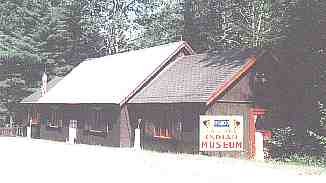
|
|
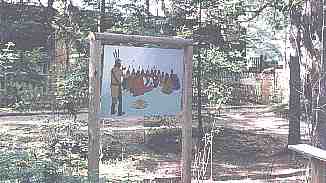
|
Ray, Christine, and John Fadden opened the Museum for its first season during the summer of 1954. The wood that went into the lumber of the initial structure was milled at a local sawmill from trees felled by Ray Fadden. The museum, originally two rooms large, expanded to four rooms.
|
|
We vehemently stress the importance of maintaining oral tradition coupled with written history for cultural continuity.
[Note: the long, thin beadworked belt just above story-teller Ray Fadden's head stretches all around the room and is probably the longest single piece of beadwork in the world.]
|
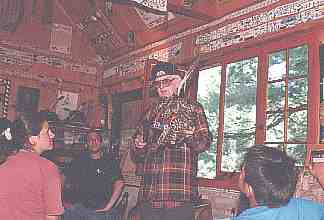
|
|
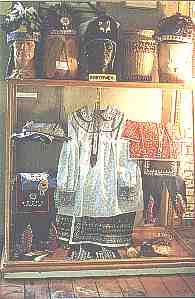
|
The Museum houses over 3000 pre-contact, and post-contact artifacts, contemporary arts and crafts, diagrammatic charts, posters, and other items of Haudenosaunee culture. The objects within the Museum are primarily representative of the Haudenosaunee, but there are artifacts of other Native American cultures as well.
There are many objects within the museum. The floors are decorated with Haudenosaunee symbol & motif, and within the rooms are cases exhibiting artifacts. The walls are laden with informative charts, beaded belts, paintings and other indigenous items of interest. Up into the peaked ceiling of each room are representations of Native America as they are covered with artifacts including canoes, baskets, tools, beadwork, feathered headgear, Native clothing, and posters.
|
|
We want to educate the public about Haudenosaunee culture. Visitors come from Africa, Asia, Europe, Australia, and the Americas, lending an inter-cultural flavor to our exchanges. They come from summer camps, summer education programs, and history/anthropology classes from several universities. The opening of the Adirondack Visitors Interpretive Center in the Spring of 1989 has expanded our visitors, because it is only about nine miles away.
|
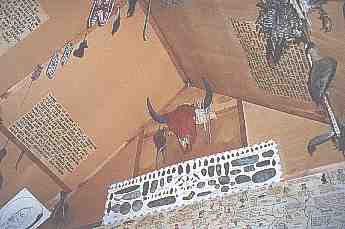
|
|
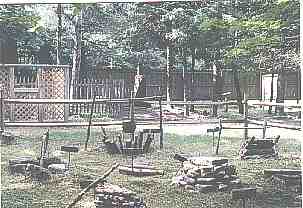
|
Another of our goals is educating the public about the Land Ethic of the Haudenosaunee, and other environmental sensitivities. The preservation of trees, plants, waters, birds, animals, and the very soil of the Earth itself is an objective. The founder, Ray Fadden, has for years done this by feeding the ravens, crows, chickadees, chipmunks, squirrels, coyotes, and bears. This process of nutritional assistance will continue because the natural habitat of these animals has been badly eroded by man: acid rain, habitat destruction, ozone depletion, over-hunting and -fishing, etc.
|
|
A third goal is to serve Native Peoples. We present information about Native cultures, and provide a place where traditional values, philosophies, and sensitivities can be reaffirmed. Native students (and non-students or former students) from such indigenous communities as Akwesasne, Kahnawake, Kanesatake, Oneida, Onondaga, and points west across New York State, and into Canada regularly visit us.
|
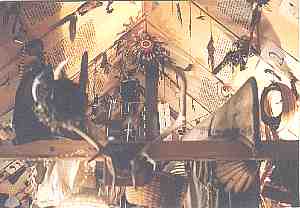
|
|
Visiting:
The museum is located in the Northeastern Adirondack Mountains of New York and is open July-August, 10AM-6PM, Tues.-Sun. (closed Mon.), open by appointment to groups from mid-May through June 30, and September. Admission is $2 for adults and $1 for children. Visitors are treated to a visual feast of Native American material supplemented with a series of lectures geared toward the situation, and needs of the audience.
Pictographic stories are read, descriptions of contributions of Native Peoples to contemporary society expressed, and the epic story of the formation of the Haudenosaunee form of participatory government is told. The Museum shop carries Mohawk baskets, beadwork, soapstone carving, wooden jewelry, and acrylic paintings reflecting Six Nations Iroquois culture.
Contact:
John Kahionhes Fadden, Director, Six Nations Indian Museum, HCR 1-Box 10, Onchiota, NY 12989 Tel: (518) 891-2299. A brochure is available by sending a self-addressed business-size envelope. redmaple@northnet.org
Some Final Thoughts
We take pride in our existence as a living museum, embodying the values and worldview of a vibrant culture.
Many museums appear to have the same goals, but in most cases, they are institutions deeply rooted in western culture, in effect presenting Native American cultures "under glass." Cultural perspective markedly affects the manner in which material is presented.
The Six Nations Indian Museum presents its material from a Native American point of view. In years past,
the Museum, through the efforts of its founder, Ray Fadden, produced a series of pamphlets, and charts on Haudenosaunee culture, and history. Specific topics included traditional Haudenosaunee clothing design,
the historiy of the Akwesasne (St. Regis) Mohawks, the history of the Oneidas, a diagram of Haudenosaunee government, folk tales, and other cultural narratives.
This series of publications was, for a long time, one of the few sources available on indigenous culture published by indigenous people. We would like to resurrect, and expand this capability. Efforts are in motion to republish Ray Fadden's work under one cover.
_____________________________________________________
Small Bead Businesses| Beading & Beadwork | Ancient Beads | Trade Beads
Beadmaking & Materials | Bead Uses | Researching Beads | Beads and People
Center for Bead Research | Book Store | Free Store | Bead Bazaar
Shopping Mall | The Bead Auction | Galleries | People | Events
The Bead Site Home | Chat Line | Contact Us | Site Search Engine| FAQ
|






